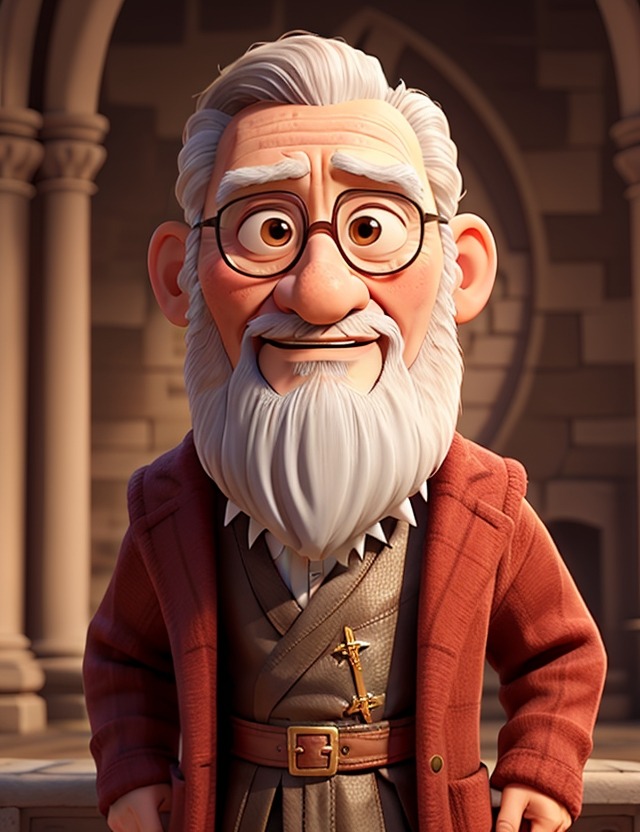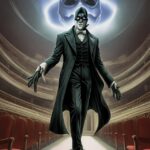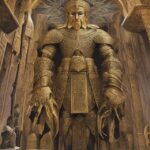Step back in time and delve into the intriguing world of one of William Shakespeare’s most renowned works – King Lear. As an acclaimed literary masterpiece, its gripping storyline, complex characters, and timeless themes continue to captivate readers across generations. In this captivating article, we unveil the secrets and profound wisdom hidden within the pages of King Lear, shedding light on the historical context, the author’s inspiration, and the deep-rooted human emotions that pulsate through every scene.
Get ready to embark on a journey that will ignite your imagination, shake your core beliefs, and leave an indelible mark on your literary sensibilities. Are you ready to unravel the enigma that is King Lear?
King Lear by William Shakespeare: Full Book Summary
Once upon a time in the magical kingdom of Britain, there lived a wise and powerful king named Lear. King Lear had three daughters: Goneril, Regan, and Cordelia. As he grew old, he decided that it was time for him to retire and hand over his kingdom to his daughters. But before doing so, he came up with a plan to test their love for him.
King Lear called his three daughters and asked them to express their love for him. Goneril, the eldest, spoke first and declared that she loved him more than anything in the world. Regan, the middle daughter, echoed her sister and professed her deep affection for her father. Lastly, Cordelia, the youngest and most beloved, began to speak. But instead of flattering her father with false words, Cordelia simply said that she loved him according to her duty, and could not express her love in words as her actions would speak louder.
King Lear was outraged by Cordelia’s response and thought she did not love him at all. He was so disappointed that he disowned Cordelia, dividing her share of the kingdom between Goneril and Regan, and banishing her from the kingdom. The King’s advisor, the Earl of Kent, who tried to speak up in Cordelia’s favor, was also banished.
However, not all was as it seemed. The King of France, who had heard of Cordelia’s virtues and true love for her father, proposed to marry her. Cordelia agreed and left the kingdom with the King of France, hoping one day to return and reconcile with her father.
As time went on, King Lear discovered that Goneril and Regan were not as loving and faithful as they had claimed to be. They soon revealed their true intentions and began mistreating their father. They reduced his servants, attacked his dignity, and even cast him out of their castles during a raging storm.
During this storm, King Lear wandered the wilderness, accompanied only by his loyal Fool and the disguised Earl of Kent, who had returned to serve his beloved King in disguise. In his madness, King Lear started to realize the true values of love, family, and loyalty that he had disregarded in his youth.
Meanwhile, the Earl of Gloucester, another nobleman in the kingdom, faced a similar struggle as he had two sons: Edgar and Edmund. Edmund, the younger and jealous son, hatched a plot to seize his father’s title and wealth by framing his brother, Edgar, for treason. As a result, Edgar was forced to flee and disguise himself as a poor beggar to survive.
While in disguise, Edgar encountered his father, Gloucester, who had been blinded by Goneril and Regan as punishment for secretly supporting King Lear. Edgar cared for his father and, using his disguise as a poor beggar, guided Gloucester to safety and helped him see the truth about his wicked children.
Back in King Lear’s kingdom, a war began to brew as France, aiding Cordelia’s cause, combined forces with the Duke of Albany, Regan’s husband, against Goneril and her husband, the Duke of Cornwall. The sisters’ greed and thirst for power grew so strong that they turned against each other, leading to a tragic end for both.
Amidst the chaos, Lear reunites with Cordelia — who forgives her father for his harsh treatment and embraces him with all her love. However, Edmund, driven by his ambition, betrayed his sisters and plotted to kill both Lear and Cordelia. His plan fails as Edgar reveals his true identity, challenges and defeats Edmund in a duel.
The play ends on a tragic note as Edmund dies, confessing his wrongdoings. But it is too late for Lear and Cordelia, as they are captured and sentenced to death. King Lear’s heart breaks when Cordelia dies, and he soon joins her in death from grief.
The kingdom is left in despair as the truth is revealed, and the surviving characters mourn the consequences of their actions. Regan and Goneril die from their self-inflicted wounds, while Kent, Edgar, and Albany pledge to restore order and justice to the troubled kingdom.
Although the story of “King Lear” is a tragic one, it teaches us many lessons. It reminds us of the importance of love, loyalty, and forgiveness in our relationships with others. It shows us the consequences of greed and the dangers of trusting appearances. And most importantly, it reminds us that even in the darkest of times, there is always hope for redemption and justice.
So, dear children, never forget the lessons of “King Lear.” Treasure your loved ones, be honest and humble, and always remember that love and loyalty are the greatest virtues of all.
King Lear: Key Themes
“King Lear” by William Shakespeare is a tragic play that explores the complex themes of power, betrayal, and the nature of madness.
1. Power: One of the central themes of “King Lear” is the abuse and misuse of power. At the beginning of the play, Lear, the aging monarch, decides to divide his kingdom among his three daughters based on their declarations of love for him. However, he is deceived by his two older daughters, Goneril and Regan, who flatter him with false praises. Lear’s decision to abdicate his power leads to disastrous consequences as Goneril and Regan turn against him and eventually strip him of his status, leaving him vulnerable and alone. Through Lear’s downfall, Shakespeare reflects on the corrupting nature of power and how those in positions of authority often fall victim to others’ manipulations.
2. Betrayal: The theme of betrayal is intricately woven throughout the play. Lear’s rash decision to divide his kingdom is driven by his unrealistic expectations of love and loyalty from his daughters. When Cordelia, the youngest and his favorite daughter, refuses to use false words to gain her share, Lear disowns her. He is betrayed not only by Goneril and Regan but also by his closest advisor, Gloucester’s illegitimate son, Edmund, who manipulates his father into turning against his legitimate son, Edgar. The betrayal of trust and loyalty serves as a catalyst for the tragic events that unfold in the play, highlighting the destructive consequences of deceit and betrayal.
3. Madness: Another significant theme in “King Lear” is the exploration of madness. Throughout the play, characters’ sanity is tested and often compromised. Lear’s descent into madness is a result of his realization of his own folly and the cruelty of his daughters. His language becomes fragmented and nonsensical, reflecting his declining mental state. Similarly, Gloucester, after having his eyes gouged out, spirals into madness but gains a newfound wisdom. Madness, in the context of the play, becomes both a symbol of the characters’ tumultuous inner worlds and a critique of the chaotic and unforgiving nature of the world they inhabit. It emphasizes the vulnerability and fragility of human existence in a world where power is abused and trust is betrayed.
In conclusion, “King Lear” tackles the themes of power, betrayal, and madness with great depth and complexity. Through Lear’s tragic journey, Shakespeare examines the consequences of the misuse of power, the devastating effects of betrayal, and the fragility of the human mind. The play serves as a timeless reminder of the dangers of greed, deceit, and the pursuit of power at the expense of genuine human connection.
King Lear: Characters
– King Lear: King Lear, an aging monarch, is the central character of the story. He starts off as a proud and demanding ruler, but as the tragedy unfolds, his descent into madness becomes evident. With his flowing white beard and regal presence, Lear commands respect. Interestingly, he is notorious for his penchant for counting and organizing his knights, much to the amusement of his courtiers.
– Cordelia: The youngest and most honest of Lear’s daughters, Cordelia possesses an ethereal beauty and gentle demeanor. While her sisters flatter their father with exaggerated declarations of love, Cordelia’s refusal to take part in the deception sets off a chain reaction of events. She has a soft spot for nature and can often be found wandering through the meadows, whispering to the flowers.
– Goneril: The conniving and power-hungry eldest daughter of King Lear, Goneril is depicted as a strikingly beautiful woman with piercing eyes and a smirking grin. Throughout the story, she embarks on a ruthless quest for control, disrespecting her father and manipulating those around her. Ironically, Goneril is rather fond of collecting fortune-telling tarot cards and indulging in a good game of solitaire.
– Regan: Goneril’s equally scheming sister, Regan, is described as possessing a commanding presence and an icy demeanor. With her perfectly coiffed hair and fierce fashion sense, she often stands out in a crowd. Regan has a peculiar affinity for collecting exotic bird feathers and has been known to spend hours meticulously arranging them in elaborate patterns on her palace walls.
– Edmund: The illegitimate son of the Earl of Gloucester and the embodiment of cunning, Edmund is a tall and dashing figure with a mischievous twinkle in his eye. Driven by ambition, he skillfully plays one family against another to further his own power. It is rumored that Edmund once won a fencing match blindfolded, astounding even the most skilled swordsmen.
– Gloucester: The loyal and trusting Earl of Gloucester is described as a weathered yet kind-hearted man with graying hair and a constant smile. He is a father figure to both Edgar and Edmund, but his unwavering faith in the latter ultimately leads to his downfall. Gloucester’s secret hobby involves tending to an elaborate collection of butterflies, which he believes hold the answers to life’s mysteries.
– Edgar: Edgar, the legitimate son of Gloucester, is portrayed as a thoughtful and compassionate young man. With his tousled brown hair and warm hazel eyes, he possesses an undeniable charm. Edgar has an affinity for writing poetry and often ventures into the woods to seek inspiration from nature. His quick thinking and ability to adapt prove vital in overcoming the challenges he faces throughout the story.
– Kent: Kent, a loyal nobleman and one of King Lear’s most trusted advisors, is a rugged and battle-hardened warrior. In his prime, he was known for his prowess on the battlefield and his unwavering loyalty. Despite his gruff exterior, Kent has a soft spot for animals, particularly stray cats, and can often be seen carrying around a pocketful of treats to win their affections.
– The Fool: The Fool in King Lear is a wise and witty jester, entrusted with providing comic relief amidst the tragedy. With his colorful and motley attire, he always manages to stand out in a crowd. The Fool carries a small book of limericks and can recite them flawlessly, much to the delight of the court and even the most stoic characters in the story.
King Lear: Symbols
1. The Storm: The storm is one of the most prominent and significant symbols in King Lear. It represents chaos, turmoil, and the destructive nature of human behavior. When King Lear is out on the heath during the storm, his outer world is a reflection of his inner turmoil. The storm also serves as a metaphor for moral blindness and the consequences of poor judgment. As the storm rages on, the characters are forced to confront their own flaws and confront the harsh realities of their actions.
2. Blindness: The theme of blindness is recurrent throughout King Lear, both literal and metaphorical. The most obvious example of literal blindness is the character of Gloucester, who is physically blinded by Cornwall. However, metaphorical blindness is more prevalent and represented through characters who are blind to the truth or unable to see the consequences of their actions. King Lear himself is blind to the true nature of his daughters’ love, while Goneril and Regan are blind to their own greed and ambition. The presence of blindness emphasizes the dangers of flawed perception and acts as a warning against ignoring reality.
3. Fool: The Fool, also known as the jester, is a significant symbol in King Lear. He represents wisdom, truth-telling, and the voice of reason amidst chaos. Contrary to his name, the Fool is often the most insightful character in the play, capable of seeing through the deceit and lies that plague the other characters. He serves as a loyal companion to Lear and is unafraid to confront him with the truth, often using humor and irony to shed light on the situation. The Fool’s presence highlights the importance of wisdom and the consequences of ignoring it, even when it comes from an unexpected source.
King Lear by William Shakespeare: Culture Impact
King Lear, one of William Shakespeare’s timeless masterpieces, holds a prominent position in literary history, leaving an enduring cultural impact that has transcended centuries. This tragic play, believed to be written between 1603 and 1606, has shaped the course of literature, inspired countless adaptations, and deeply influenced society’s perception of power, human nature, and familial relationships.
Historically, King Lear marked a significant juncture in Shakespeare’s career, representing his transition from writing primarily comedies to exploring the depths of tragedy. Its performance at the court of King James I in 1606 showcased Shakespeare’s newfound artistic maturity and his ability to tackle complex themes with compelling theatricality. The play’s controversial aspect, particularly its exploration of madness, showcased Shakespeare’s audacity, setting a new precedent for the dramatic arts of the time.
The impact of King Lear on culture is undeniable, with numerous funny and memorable moments finding their way into modern storytelling. Lines such as “I am a man more sinned against than sinning” and “How sharper than a serpent’s tooth it is to have a thankless child!” have become widely known and regularly quoted, achieving a kind of immortality in the English language. King Lear’s fool, with his witty retorts and clever wordplay, has also left an indelible mark on the comedic tradition in literature, inspiring characters and archetypes in later works.
Furthermore, King Lear has become a source of inspiration for a wide array of artistic adaptations across different mediums. Countless stage productions have been mounted worldwide, each interpreting the play with fresh perspectives and innovative staging. Noteworthy film adaptations, such as Akira Kurosawa’s “Ran” and Laurence Olivier’s 1983 version, have brought King Lear to a larger audience, showcasing its universal themes and resonating with contemporary viewers.
The achievements of King Lear extend beyond the realms of literature and the arts. King Lear’s portrayal of power struggles, family dynamics, and the disintegration of societal norms has had a profound impact on our understanding of human nature and the complexities of human relationships. The play explores themes of greed, betrayal, and the consequences of pride, evoking a profound reflection on human vulnerability, moral ambiguity, and the fragility of sanity. These universal themes continue to resonate with audiences of all backgrounds and have given rise to numerous psychological interpretations and analyses.
In conclusion, King Lear, with its historic significance, funny anecdotes, and cultural achievements, continues to shape the fabric of our society and influences our understanding of human nature. Shakespeare’s play has stood the test of time, remaining a pillar of literature, inspiring countless adaptations, and offering a thought-provoking examination of power, family, and the human condition. Its impact will endure, ensuring that King Lear’s legacy lives on for generations to come.
FAQs
1. What is the main theme of King Lear?
The theme of King Lear is the relationship between appearance and reality, and the consequences of deception and self-deception. The play shows how characters are misled by their own illusions and by the lies of others, and how this leads to their downfall and suffering. For example, Lear is deceived by the false love of Goneril and Regan, and by his own pride and vanity. He rejects the true love of Cordelia, and realizes his mistake too late. Gloucester is deceived by the false loyalty of Edmund, and by his own superstition and blindness. He disowns the true loyalty of Edgar, and suffers physical and emotional pain. Goneril and Regan are deceived by the false charm of Edmund, and by their own greed and ambition. They betray their father and each other, and die by their own hands. Edmund is deceived by his own cunning and wickedness, and by the justice of the gods. He betrays his father and brother, and is killed by Edgar. The play also shows how characters are able to see the truth and overcome their illusions, through suffering and wisdom. For example, Lear gains insight and compassion through his madness and misery. He reconciles with Cordelia, and asks for her forgiveness. Gloucester gains perspective and courage through his blindness and despair. He recognizes Edgar, and accepts his fate. Edgar gains strength and virtue through his disguise and hardship. He defends his father and kills Edmund. Cordelia and Kent remain faithful and honest throughout the play, and do not succumb to any illusions.
2. What is the significance of the Fool in King Lear?
The Fool serves as a voice of reason and truth throughout the play. He often uses humor and wit to comment on the actions of the characters, particularly Lear. The Fool’s presence highlights the themes of folly and wisdom, and his departure from the play signifies the descent into chaos.
3. What is the role of the character Cordelia in King Lear?
Cordelia is one of King Lear’s daughters and is portrayed as the epitome of loyalty and love. Despite being honest and refusing to flatter Lear, she is banished by her father. Cordelia’s character highlights the theme of unconditional love and provides contrast to her deceitful sisters, Goneril and Regan.
4. How does King Lear explore the concept of justice?
King Lear delves into the idea of justice by showcasing the consequences of unjust actions. Characters like Goneril, Regan, and Edmund engage in treacherous schemes that ultimately lead to their downfall. The play questions whether vengeance or forgiveness is the appropriate form of justice.
5. What is the significance of the storm in King Lear?
The storm in King Lear symbolizes the turmoil and chaos that ensues as the play progresses. It reflects Lear’s internal state of mind and his descent into madness. The storm also serves as a metaphor for the breakdown of social order and the destructive consequences of hubris.
6. What is the plot summary of King Lear?
King Lear is a play that tells the story of an aging king who decides to divide his kingdom among his three daughters, based on their declarations of love for him. However, his plan backfires when his youngest and most loyal daughter, Cordelia, refuses to flatter him, and he banishes her. His other two daughters, Goneril and Regan, who have lied about their love, turn against him and strip him of his power and dignity. Meanwhile, a parallel plot involves the Earl of Gloucester, who is betrayed by his illegitimate son Edmund and blinded by Regan’s husband Cornwall. Gloucester’s legitimate son Edgar, who is disguised as a mad beggar, helps his father and eventually kills Edmund. The play ends with a tragic climax, in which Cordelia is hanged by Edmund’s order, and Lear dies of grief after holding her body. Goneril and Regan also die, as Goneril poisons Regan and then stabs herself, out of jealousy over Edmund. Edgar and Kent, Lear’s loyal followers, are left to restore order and justice in the kingdom.
7. Who are the main characters of King Lear?
The main characters of King Lear are King Lear, Cordelia, Goneril, Regan, Gloucester, Edgar, Edmund, Kent, and the Fool. King Lear is the protagonist and the tragic hero of the play, a proud and foolish king who suffers a downfall due to his own mistakes and the treachery of his daughters. Cordelia is Lear’s youngest and most virtuous daughter, who loves him sincerely but does not flatter him. She is banished by Lear, but later returns with a French army to save him. Goneril and Regan are Lear’s eldest and wicked daughters, who lie about their love for him and plot to overthrow him. They are also rivals for the love of Edmund, whom they both marry. Gloucester is a nobleman and a friend of Lear, who is deceived by his bastard son Edmund and blinded by Cornwall. He is loyal to Lear and Cordelia, and is helped by his legitimate son Edgar. Edgar is Gloucester’s good and rightful heir, who is forced to flee and disguise himself as a mad beggar, called Poor Tom. He protects his father and kills Edmund in a duel. Edmund is Gloucester’s evil and illegitimate son, who schemes to usurp his father and brother’s titles and lands. He is also a lover of both Goneril and Regan, and orders the execution of Cordelia. Kent is a loyal and honest servant of Lear, who disguises himself as a peasant, called Caius, after being banished by Lear for defending Cordelia. He follows and serves Lear throughout his troubles, and dies of grief after Lear’s death. The Fool is Lear’s jester and companion, who speaks the truth in riddles and jokes. He mocks and criticizes Lear for his folly, and tries to comfort him in his madness.
8. What is the symbolism of King Lear?
The symbolism of King Lear is a topic that has been explored by many critics and readers. The title itself suggests a contrast between the authority and dignity of a king and the vulnerability and madness of a lear. Some possible interpretations of the symbols in the play are:
The storm could symbolize the chaos and disorder that result from Lear’s division of his kingdom and his daughters’ betrayal. The storm also reflects Lear’s inner turmoil and rage, as he rants and raves against his enemies and the gods. The storm also represents the natural and cosmic forces that are beyond human control and understanding, and that challenge the human notions of justice and reason.
The blindness could symbolize the lack of insight and judgment that characterizes the characters in the play, especially Lear and Gloucester. The blindness also contrasts the physical and moral vision of the characters, as Gloucester loses his eyes but gains wisdom, while Lear retains his eyes but loses his mind. The blindness also suggests the theme of appearance and reality, as the characters are unable to see the truth and the consequences of their actions.
The wheel of fortune could symbolize the unpredictability and instability of human life and fate, as well as the role of the gods and fortune in determining the outcomes of the events. The wheel of fortune also shows the rise and fall of the characters, as Lear and Gloucester lose their power and status, while Edmund and Edgar gain them. The wheel of fortune also implies the theme of justice and injustice, as the characters suffer or prosper according to their virtues or vices.
The clothing could symbolize the identity and status of the characters, as well as the theme of appearance and reality. The clothing also shows the changes and transformations of the characters, as they wear different costumes or strip off their garments. For example, Lear and Edgar disguise themselves as beggars, Kent disguises himself as a peasant, and Goneril and Regan dress up as queens. The clothing also reveals the inner states and emotions of the characters, as they express their feelings through their attire. For example, Lear tears off his clothes in his madness, Gloucester covers his eyes with a bandage in his shame, and Cordelia wears white in her innocence.
9. What is the setting of King Lear?
The setting of King Lear is the ancient and mythical Britain, before the Roman invasion and the Christian conversion. The play does not specify the exact time and place of the events, but it is based on the historical and legendary sources of the life of King Leir, a Celtic king who ruled Britain in the 8th century BC. The setting reflects the political and social conditions of the pre-Christian Britain, as well as the cultural and religious beliefs of the pagan and druidic traditions. The setting also creates a contrast between the historical and the fictional, the realistic and the fantastical, and the universal and the particular.










